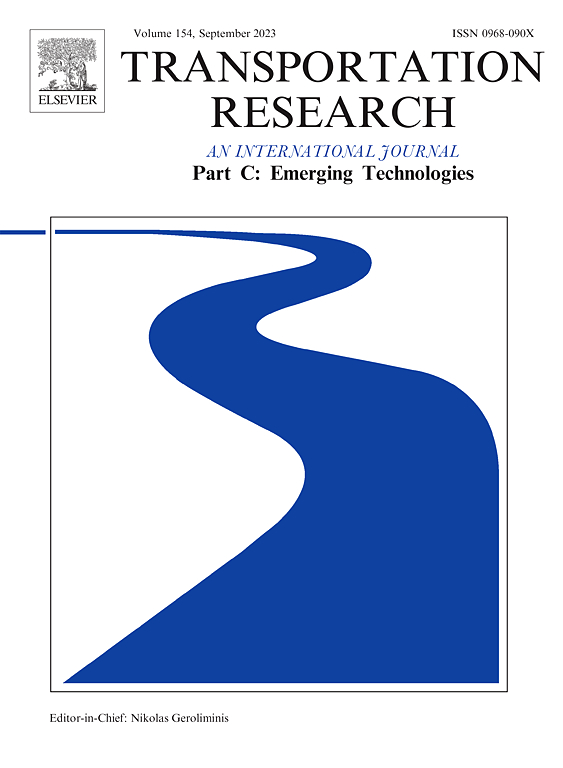基于事件触发的异构车辆队列协同轨迹协调
IF 7.6
1区 工程技术
Q1 TRANSPORTATION SCIENCE & TECHNOLOGY
Transportation Research Part C-Emerging Technologies
Pub Date : 2025-02-25
DOI:10.1016/j.trc.2025.105049
引用次数: 0
摘要
本文讨论了实现具有异构动力学的车辆间合作的问题。在轨迹规划层取代运动控制层实现了车际协作,克服了动力学失配带来的挑战。提出了一种基于动态触发分布式通信网络的滑模协同规划方案。为了保证生成轨迹的实用性,对每辆车都考虑了速度约束和输入饱和现象。首先设计了一个参考滤波器,将任务信息转化为光滑的可跟踪曲线。然后引入势垒Lyapunov函数方法,通过保持规划轨迹与实际轨迹之间的差异来增强轨迹的可达性。通过提出一种新的协同误差,提出了用于分布式车辆通信的静态触发和动态触发方案。以地空多车系统为例,进行了对比仿真,验证了设计的有效性。本文章由计算机程序翻译,如有差异,请以英文原文为准。
Event triggered cooperative trajectory coordination for platooning among heterogeneous vehicles
This article addresses the issue of achieving inter-vehicle cooperation for vehicles with heterogeneous dynamics. Inter-vehicle collaboration is achieved in the trajectory planning layer instead of the motion control layer to conquer the challenge led by dynamics mismatch. A novel sliding mode cooperative planning scheme is proposed based on a dynamically triggered distributed communication network. To ensure the practicality of the generated trajectories, both velocity constraints and input saturation phenomenon are considered for each vehicle. A reference filter is first designed to transform task information into smooth and trackable curves. The barrier Lyapunov function approach is then introduced to enhance the reachability of the trajectories by maintaining the difference between the planned trajectories and the actual trajectories. By proposing a new cooperative error, static and dynamic trigger schemes are developed for distributed vehicle communication. Comparative simulations regarding a ground–air multi-vehicle system are conducted to validate the effectiveness of our designs.
求助全文
通过发布文献求助,成功后即可免费获取论文全文。
去求助
来源期刊
CiteScore
15.80
自引率
12.00%
发文量
332
审稿时长
64 days
期刊介绍:
Transportation Research: Part C (TR_C) is dedicated to showcasing high-quality, scholarly research that delves into the development, applications, and implications of transportation systems and emerging technologies. Our focus lies not solely on individual technologies, but rather on their broader implications for the planning, design, operation, control, maintenance, and rehabilitation of transportation systems, services, and components. In essence, the intellectual core of the journal revolves around the transportation aspect rather than the technology itself. We actively encourage the integration of quantitative methods from diverse fields such as operations research, control systems, complex networks, computer science, and artificial intelligence. Join us in exploring the intersection of transportation systems and emerging technologies to drive innovation and progress in the field.

 求助内容:
求助内容: 应助结果提醒方式:
应助结果提醒方式:


